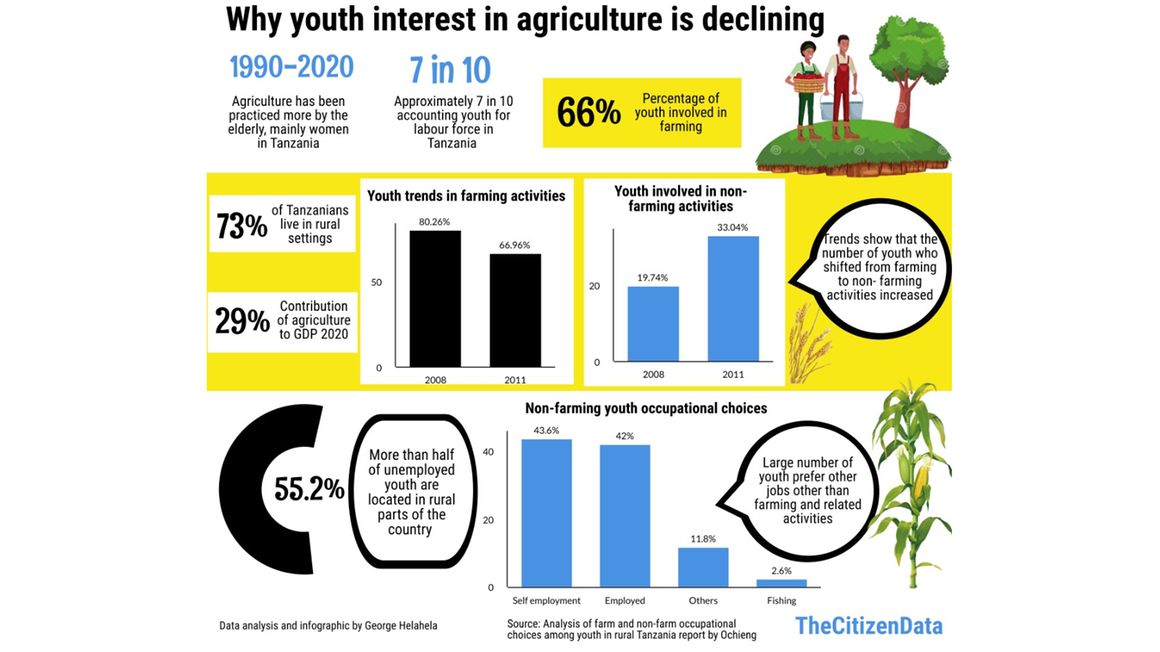
Our Projects are
Transforming African Trade
Quick Contacts
2nd Floor, Fidelity Insurance Centre Waiyaki Way, Westlands

Summary
Dar es Salaam. As the single most important economic sector in Tanzania, agriculture should provide most of the employment slots in the country. As a matter of fact, the sector can – and should – provide more jobs if Tanzania is to solve its unemployment problem in the next 60 years, experts say.
Despite promises of creating employment opportunities made by politicians in election campaigns, millions of youth remain either unemployed or underemployed. The failure to facilitate the deployment of the youth into agriculture means that the economy can’t harness all its labour potential. The opportunity to use agriculture to end poverty is also wasted when the unemployed youth stay away from agriculture. This is because, according to researcher Nelson Albert Ochieng, “Evidence abound that investment in agriculture is more effective in reducing poverty compared to investment in non-agriculture sectors.”
In the past 60 years – specifically in the last three decades – agriculture has been practiced more by the elderly, mainly women. In the first three decades after independence in 1961, there were policies in place to restrict mass rural/urban migration. In rural areas, the youth were encouraged to start developmental villages.
In urban areas laws against loitering were put to much effect to prevent idling, and by extension, rural-urban migration. But, after economic liberalisation, when some of the policies became obsolete the youth started moving out of rural areas with speed to non-farming activities in urban or semi-urban areas. A study by Ochieng shows that youth movement from farming to non-farming activities was the highest in the three years from 2008 to 2011.
And yet the non-farming activities have not proven to be adequate enough to absorb the entire job seeking young men and women who join the labour force annually. In 2008, about 80.26 percent of the youth in the labour force were in agriculture. In 2011, the number had declined to 66.96 percent. The percentage of youth engaged in non-farming activities, on the other hand, increased from 19.74 to 33.04 percent in the same period.
Various government reports show that the youth account for about 67 percent of the total labour force. What is interesting, according to the Tanzania mainland integrated labour force survey of 2014, is that more than half of unemployed youth are in the rural areas.
In a research he conducted on why the youth move away from agriculture, Ochieng found that the youth show displeasure with agriculture because they get fewer returns against their expectations. “Furthermore, the rain-fed agriculture system that exists in rural areas results in seasonal unemployment during non-farming periods. Therefore, the majority of youth engage in other non-farm activities including – but not limited to -motorcycle taxis (bodabodas), carpentry and petty trading,” says Ochieng.
Ochieng adds that most youth do not take agriculture as a profession and are, therefore, likely to be attracted by other emerging opportunities other than farming.
The odds are on State side
It seems ludicrous that, after 60years if Independence, anyone would expect the government to create employment for the millions of un/underemployed youth. But, some experts say the role of the government is still crucial to correct some defective policies of the past and to fulfill its obligations of the social contract.
Developments in the past decade or so have made a return by the youth to agriculture possible, experts say. In fact, they argue, the nature of agriculture has changed so much that it is no longer a rural preserve. The research conducted by Ochieng showed that youth in semi-urban – and even in urban – areas are turning back to agriculture to cultivate highly commercialised fruits and vegetables: avocados, tomatoes, carrots, eggplants, cucumbers and watermelons.
So, the password to unlocking the youth interests is solving the market problem, experts say. Time has come for the government to review its policy stance on cross-border trade of cereals once and for all. The current reprieve was effectuated by President John Magufuli, but it is not clear whether it is a permanent move or a temporary one.
Once the government solves the market, facilitates the creation of mini-irrigation schemes using boreholes, then Tanzania is bound to see a reversal of rural/urban youth migration. The mini-irrigation schemes will solve the problem of unemployment in the dry seasons.
Rural areas in Tanzania are no longer what they were when rustics were forced into Ujamaa villages in the early 1970s. During that time, not only were villages but also a good number of regional headquarters in the middle of nowhere were inaccessible and with unreliable means of communication.
Today, most villages are accessible or within reach of thousands of kilometres of bituminised roads. Mobile telephone networks are available in villages. The creation of rural water authorities has improved access to potable water in most villages. Rural electrification efforts have seen many villages electrified. These factors could seem trivial but they increase the appeal of villages to the youth.
In his study, Ochieng recommends introducing agriculture as a study subject in primary schools, changing the perception of youth towards farming, and encouraging a land tenure system that allows full ownership of farming land.
Getting the youth back to agriculture has other benefits for the nation. The crucial role of agriculture goes beyond employment in terms of providing food for the nation and in terms of its high potential for helping Tanzania diversify is exports basket.
Read original article
Disclaimer: The views and opinions expressed in this article are those of the authors and do not necessarily reflect the official policy or position of TradeMark Africa.